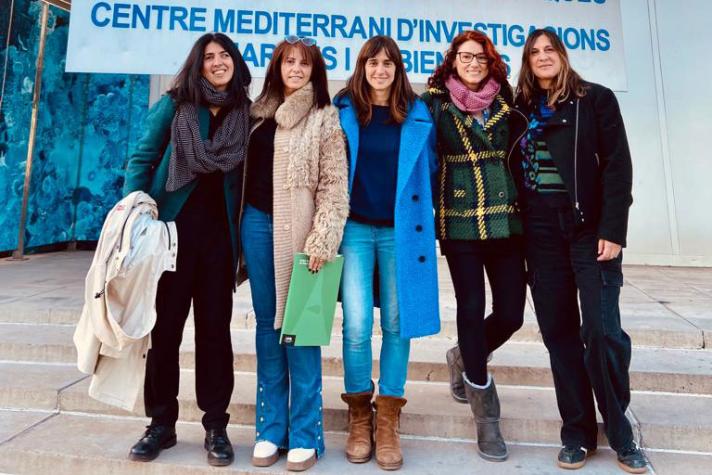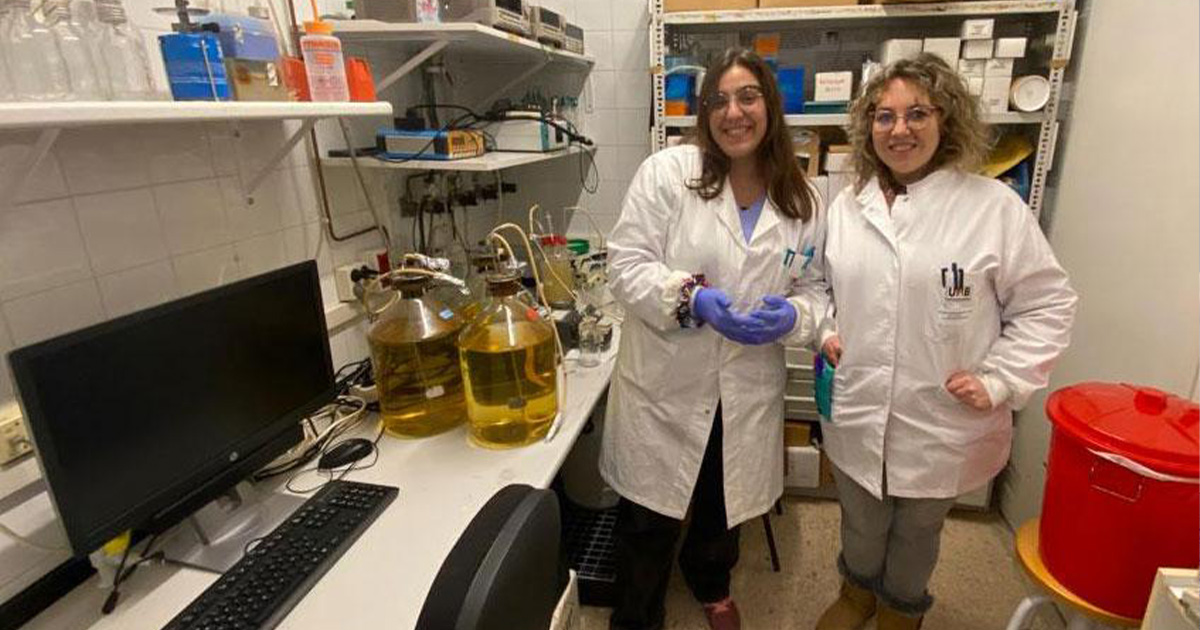MER-CLUB is an ambitious scientific project which aims to tackle the issue of mercury pollution in marine sediments. Mercury pollution is a global problem with large environmental, socio-economic, and health impacts.
The MER-CLUB project is developing a clean-up system based on bioremediation, a green technology that uses the potential of natural microbes to break down harmful pollutants.
From polluted sites, the team of scientists has successfully isolated promising microbial candidates capable of detoxifying mercury (Hg) in vitro.
The project is now entering into its final stage, testing these promising microbes in natural sediments. Coordinated by AZTI in Spain, the project is supported by the European Maritime and Fisheries Fund and gathers partners in France, Sweden, Germany, and Spain.
 Scientists from the MER-CLUB team together with CINEA project officer. From left to right: Laura Kottos (CINEA), Olga Sánchez (UAB), Laura Alonso-Sáez (Coordinator, AZTI), Andrea Garcia Bravo (ICM-CSIC), Silvia G. Acinas (ICM-CSIC). (Image credit: European Commission)
Scientists from the MER-CLUB team together with CINEA project officer. From left to right: Laura Kottos (CINEA), Olga Sánchez (UAB), Laura Alonso-Sáez (Coordinator, AZTI), Andrea Garcia Bravo (ICM-CSIC), Silvia G. Acinas (ICM-CSIC). (Image credit: European Commission)
Mercury: A Danger for Our Ocean and Ourselves
Not only do our waste and fishing nets contribute to the pollution of our freshwater and ocean but also chemical products that end up in the water. Mercury (Hg) is one of the most dangerous natural pollutants. However, like other sources of pollution, there are natural solutions available.
The MER-CLUB project is playing a crucial role in supporting the European Zero Pollution Action Plan by developing a clean-up system to remove mercury from the marine environment.
Using Biological Processes to Remove Mercury
Bioremediation is a process that relates to the use of natural microorganisms to consume and break down environmental pollutants. MER-CLUB aims to target the variety of marine Hg detoxifiers with the ultimate goal of naturally cleansing the marine environment of mercury contamination. Since its launch in 2020, the project has been quite a success:
Laura Alonso-Sáez, the coordinator of the MER-CLUB project, says: “In 3 years, we have gone down the road from understanding which microbes carry out Hg detoxification in complex marine sediments to bringing into culture some promising candidates for Hg bioremediation. This has been already a great undertaking and making it work in natural sediments is the next challenge.”
Promising Marine Sediments
To decontaminate, marine sediments are used, not only because they are the final repository of most environmental pollutants, but also because this is where most crucial Hg biogeochemical processes take place. Key to these processes are the sediment bacteria which drive both the harmful and beneficial aspects of the cycle. While some of them produce extremely toxic substances which accumulate in the food chain and pose a danger to human health, others hold significant value for their ability to neutralize toxins and are, therefore, interesting for bioremediation.
Silvia G. Acinas from ICM-CSIC, who is in charge of building a Hg-detoxification reference gene catalog from MER-CLUB samples collected from Mediterranean, Atlantic and Baltic sediments, says: “In only 30 sediment samples, we have compiled a gene catalog containing 16 million non-redundant genes, which displayed a high level of novelty. More than 50% of these genes are still unidentified, holding significant potential for future blue biotechnology applications.”
After successfully isolating marine bacterial cultures and consortia with Hg-detoxifying capabilities in vitro, we are now testing their performance in microcosms with natural sediments at SLU (Sweden) as a preliminary step before upscaling.
Nerea Duroudier and Ibon Lekue from the private company AFESA (Spain), who will be in charge of building the bioremediation pilot plant at the final stage of the project, says: “Traditional Hg removal approaches have been mainly based on landfill disposal and thermal processes, which are not environmentally sustainable options. The development of a successful bioremediation technology would be a great step forward in many ways, even if obtaining a technically and economically viable bioprocess at the industrial scale remains highly challenging.”
A Success Story Also for Researchers
In addition to its positive impact on the environment this project is also an excellent opportunity for career researchers in emerging fields.
Carla Pereira, UAB, said: “MER-CLUB has given me the opportunity to do a Ph.D. focused on what I like most, the sea. As an environmentalist, it is a privilege to have the chance to make our oceans healthier. Being part of this great group of scientists has been truly an extraordinary experience.”
This is also the case of the Ph.D. student Carla Pereira, the junior postdoctoral researcher Elena Hernández del Amo or the tenure track researcher Andrea García Bravo (ICM-CSIC) who said:
“Participating in MER-CLUB has allowed me to interact with an interdisciplinary group of scientists and, for the first time, with a company, which has been a wonderful experience! MER-CLUB has fostered my career and might increase my chances of getting a permanent position in the next few years.”
Furthermore, according to a recent study, three women scientists from the Mer-Club consortium are among the top 5,000 women working in Spanish institutions: Andrea García Bravo, Olga Sánchez and Laura Alonso-Sáez.



